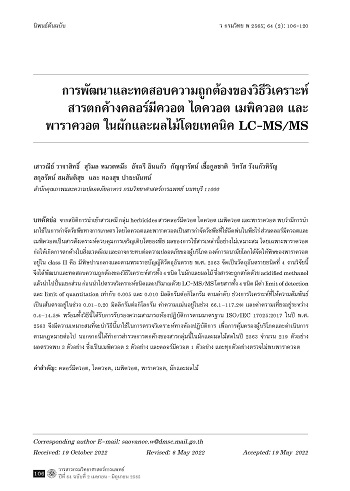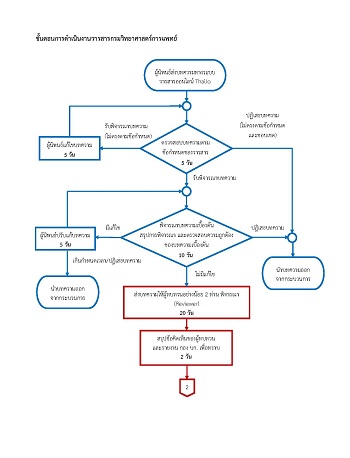การพัฒนาและทดสอบความถูกต้องของวิธีวิเคราะห์สารตกค้างคลอร์มีควอต ไดควอต เมพิควอต และพาราควอต ในผักและผลไม้โดยเทคนิค LC-MS/MS
คำสำคัญ:
คลอร์มีควอต, ไดควอต, เมพิควอต, พาราควอต, ผักและผลไม้บทคัดย่อ
จากสถิติการนำเข้าสารเคมี กลุ่ม herbicides สารคลอร์มีควอต ไดควอต เมพิควอต และพาราควอต พบว่ามีการนำมาใช้ในการกำจัดวัชพืชทางการเกษตร โดยไดควอตและพาราควอตเป็นสารกำจัดวัชพืชที่ใช้ฉีดพ่นในพืชไร่ ส่วนคลอร์มีควอตและเมพิควอตเป็นสารสังเคราะห์ควบคุมการเจริญเติบโตของพืช ผลของการใช้สารเหล่านี้อย่างไม่เหมาะสม โดยเฉพาะพาราควอตก่อให้เกิดการตกค้างในสิ่งแวดล้อม และอาจกระทบต่อความปลอดภัยของผู้บริโภค องค์การอนามัยโลกได้จัดให้พิษของพาราควอตอยู่ใน class II คือ มีพิษปานกลางและตามพระราชบัญญัติวัตถุอันตราย พ.ศ. 2563 จัดเป็นวัตถุอันตรายชนิดที่ 4 งานวิจัยนี้จึงได้พัฒนาและทดสอบความถูกต้องของวิธีวิเคราะห์สารทั้ง 4 ชนิด ในผักและผลไม้ ซึ่งสารจะถูกสกัดด้วย acidified methanol แล้วนำไปปั่นแยกส่วน ก่อนนำไปตรวจวิเคราะห์ชนิดและปริมาณด้วย LC-MS/MS โดยสารทั้ง 4 ชนิด มีค่า limit of detection และ limit of quantitation เท่ากับ 0.005 และ 0.010 มิลลิกรัมต่อกิโลกรัม ตามลำดับ ช่วงการวิเคราะห์ที่ให้ความสัมพันธ์ เป็นเส้นตรงอยู่ในช่วง 0.01–0.20 มิลลิกรัมต่อกิโลกรัม ค่าความแม่นอยู่ในช่วง 66.1–117.2% และค่าความเที่ยงอยู่ระหว่าง 0.4–14.5% พร้อมทั้งวิธีนี้ได้รับการรับรองความสามารถห้องปฏิบัติการตามมาตรฐาน ISO/IEC 17025:2017 ในปี พ.ศ. 2563 จึงมีความเหมาะสมที่จะนำวิธีนี้มาใช้ในการตรวจวิเคราะห์ทางห้องปฏิบัติการ เพื่อการคุ้มครองผู้บริโภคและดำเนินการตามกฎหมายต่อไป นอกจากนี้ได้ทำการสำรวจการตกค้างของสารกลุ่มนี้ในผักและผลไม้สดในปี 2563 จำนวน 219 ตัวอย่าง ผลตรวจพบ 3 ตัวอย่าง ซึ่งเป็นเมพิควอต 2 ตัวอย่าง และคลอร์มีควอต 1 ตัวอย่าง และทุกตัวอย่างตรวจไม่พบพาราควอต
เอกสารอ้างอิง
Bauer A, Luetjohann J, Rohn S, Kuballa J, Jantzen E. Development of an LC-MS/MS method for simultaneous determination of the quaternary ammonium herbicides paraquat, diquat, chlormequat, and mepiquat in plantderived commodities. Food Anal Methods 2018; 11: 2237-43.
Chamkasem N, Morris CJ, Harmon T. Determination of paraquat and diquat in potato by liquid chromatography/tandem mass spectrometer. J Regul Sci 2017; 05: 1-8.
Pizzutti IR, Vela GM, de Kok A, Scholten JM, Dias JV, Cardoso CD, et al. Determination of paraquat and diquat: LC-MS/MS optimization and validation. Food Chem 2016; 209: 248-55.
กรมควบคุมมลพิษ กระทรวงวิทยาศาสตร์ เทคโนโลยีและสิ่งแวดล้อม. พาราควอต (Paraquat). พิมพ์ครั้งที่ 2. กรุงเทพฯ: ฝ่ายศูนย์ข้อมูลสารอันตรายและอนุสัญญากองจัดการสารอันตรายและกากของเสีย; 2541. หน้า 7-12.
คณะแพทยศาสตร์โรงพยาบาลรามาธิบดี มหาวิทยาลัยมหิดล. สารเคมีกำจัดวัชพืช (Herbicides). [ออนไลน์]. 2542; [สืบค้น 25 ม.ค. 2565]; [4 หน้า]. เข้าถึงได้ที่: URL: https://med.mahidol.ac.th/poisoncenter/th/bulletin/bul99/v7n3/Herb.
กรมวิชาการเกษตร สำนักงานเศรษฐกิจการเกษตร. ข้อมูลเศรษฐกิจการเกษตร. [ออนไลน์]. 2565; [สืบค้น 25 ม.ค. 2565]; [1 หน้า]. เข้าถึงได้ที่: URL: https://www.oae.go.th/view/1/ปัจจัยการผลิต/TH-TH.
World Health Organization. The WHO recommended classification of pesticide by hazard and guidelines to classification 2000-2002 (WHO/IPCS/01.5). [online]. 2002; [cited 25 Jan 2022]; [58 screens]. Available from: URL: https://apps.who.int/iris/handle/10665/42524.
United States Environmental Protection Agency. R.E.D. FACTS paraquate dichloride. Prevention, pesticides and toxic substances (7508W). [online]. 1997; [cited 25 Jan 2022]; [12 screens]. Available from: URL: https://www3.epa.gov/pesticides/chem_search/reg_actions/reregistration/fs_PC-061601_1-Aug-97.pdf.
Commission Implementing Regulation (EU) 2018/1532 of 12 October 2018 concerning the non-renewal of approval of the active substance diquat, in accordance with Regulation (EC) No 1107/2009 of the European Parliament and of the Council concerning the placing of plant protection products on the market, and amending Commission Implementing Regulation (EU) No 540/2011. Official Journal of the European Union 2018: L 257/10-L 257/12.
พระราชบัญญัติวัตถุอันตราย พ.ศ. 2535 ประกาศกระทรวงอุตสาหกรรม เรื่อง บัญชีรายชื่อวัตถุอันตราย ฉบับที่ 6 (พ.ศ. 2563). ราชกิจจานุเบกษา เล่ม 137 ตอนพิเศษ 117 ง (วันที่ 19 พฤษภาคม 2563) หน้า 56.
พระราชบัญญัติอาหาร พ.ศ. 2522 ประกาศกระทรวงสาธารณสุข ฉบับที่ 419 (พ.ศ. 2563) เรื่อง อาหารที่มีสารพิษตกค้าง ฉบับที่ 3. ราชกิจจานุเบกษา เล่ม 137 ตอนพิเศษ 257 ง (วันที่ 2 พฤศจิกายน 2563) หน้า 27.
Kaczynski P. Clean-up and matrix effect in LC-MS/MS analysis of food of plant origin for high polar herbicides. Food Chem 2017; 230: 524-31.
Halim N, Kuntom A, Shinde R, Banerjee K. Determination of paraquat residues in palm oil by high-performance liquid chromatography with UV and tandem mass spectrometry. Eur J Lipid Sci Technol 2019; 121: 1900092. (7 pages).
Esparza X, Moyano E, Galceran MT. Analysis of chlormequat and mepiquat by hydrophilic interaction chromatography coupled to tandem mass spectrometry in food samples. J Chromatogr A 2009; 1216: 4402-6.
European Commission (EURL-SRM). Quick method for the analysis of numerous highly polar pesticides in foods of plant origin via LC-MS/MS involving simultaneous extraction with methanol. (QuPPe-Method) version 8.1. [online]. 2015; [cited 25 Jan 2022]; [60 screens] Available from: URL: https://www.eurl-pesticides.eu/library/docs/srm/meth_QuPPe.pdf.
Commission Decision of 12 August 2002. Implementing Council Directive 96/23/EC concerning the performance of analytical methods and the interpretation of results. Official Journal of the European Communities 2002: L221/8-L221/36.
Fajgelj A, Ambrus A, editors. Principles and practices of method validation. Cambridge, UK: The Royal Society of Chemistry; 2000.
Ellison SLR, Williams A, editors. EURACHEM/CITAC guide: quantifying uncertainty in analytical measurement. 3rd ed. United Kingdom: EURACHEM/CITAC; 2012.

ดาวน์โหลด
เผยแพร่แล้ว
รูปแบบการอ้างอิง
ฉบับ
ประเภทบทความ
สัญญาอนุญาต
ลิขสิทธิ์ (c) 2022 วารสารกรมวิทยาศาสตร์การแพทย์

อนุญาตภายใต้เงื่อนไข Creative Commons Attribution-NonCommercial-NoDerivatives 4.0 International License.



